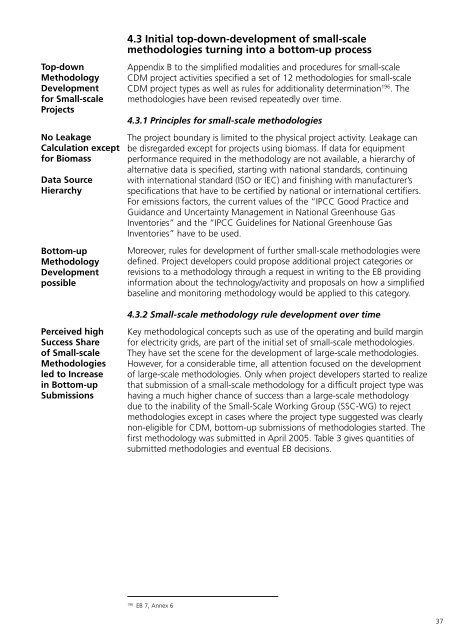Understanding CDM Methodologies - SuSanA
Understanding CDM Methodologies - SuSanA
Understanding CDM Methodologies - SuSanA
You also want an ePaper? Increase the reach of your titles
YUMPU automatically turns print PDFs into web optimized ePapers that Google loves.
Top-down<br />
Methodology<br />
Development<br />
for Small-scale<br />
Projects<br />
No Leakage<br />
Calculation except<br />
for Biomass<br />
Data Source<br />
Hierarchy<br />
Bottom-up<br />
Methodology<br />
Development<br />
possible<br />
4.3 Initial top-down-development of small-scale<br />
methodologies turning into a bottom-up process<br />
Appendix B to the simplified modalities and procedures for small-scale<br />
<strong>CDM</strong> project activities specified a set of 12 methodologies for small-scale<br />
<strong>CDM</strong> project types as well as rules for additionality determination 196 . The<br />
methodologies have been revised repeatedly over time.<br />
4.3.1 Principles for small-scale methodologies<br />
The project boundary is limited to the physical project activity. Leakage can<br />
be disregarded except for projects using biomass. If data for equipment<br />
performance required in the methodology are not available, a hierarchy of<br />
alternative data is specified, starting with national standards, continuing<br />
with international standard (ISO or IEC) and finishing with manufacturer’s<br />
specifications that have to be certified by national or international certifiers.<br />
For emissions factors, the current values of the “IPCC Good Practice and<br />
Guidance and Uncertainty Management in National Greenhouse Gas<br />
Inventories” and the “IPCC Guidelines for National Greenhouse Gas<br />
Inventories” have to be used.<br />
Moreover, rules for development of further small-scale methodologies were<br />
defined. Project developers could propose additional project categories or<br />
revisions to a methodology through a request in writing to the EB providing<br />
information about the technology/activity and proposals on how a simplified<br />
baseline and monitoring methodology would be applied to this category.<br />
4.3.2 Small-scale methodology rule development over time<br />
Perceived high<br />
Success Share<br />
of Small-scale<br />
<strong>Methodologies</strong><br />
led to Increase<br />
in Bottom-up<br />
Submissions<br />
Key methodological concepts such as use of the operating and build margin<br />
for electricity grids, are part of the initial set of small-scale methodologies.<br />
They have set the scene for the development of large-scale methodologies.<br />
However, for a considerable time, all attention focused on the development<br />
of large-scale methodologies. Only when project developers started to realize<br />
that submission of a small-scale methodology for a difficult project type was<br />
having a much higher chance of success than a large-scale methodology<br />
due to the inability of the Small-Scale Working Group (SSC-WG) to reject<br />
methodologies except in cases where the project type suggested was clearly<br />
non-eligible for <strong>CDM</strong>, bottom-up submissions of methodologies started. The<br />
first methodology was submitted in April 2005. Table 3 gives quantities of<br />
submitted methodologies and eventual EB decisions.<br />
196<br />
EB 7, Annex 6<br />
37

















